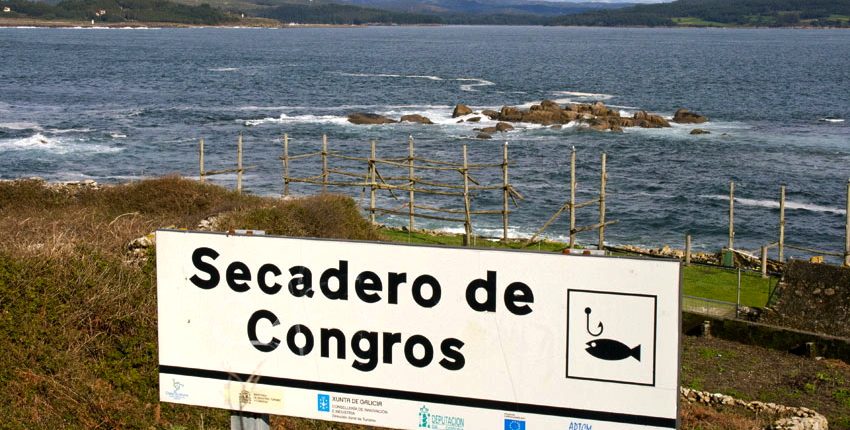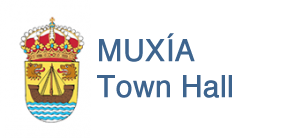Route town of Muxía
A Cruz – Port routines

We start our walk at A Cruz viewpoint, next to the beach of the same name, and head towards the harbour. On the way, on our left on the other side of the road, we will come across a monument to local poet Gonzalo López Abente (1878 -1963), known as the “poet of the sea”.
On the right, going round the jetties, we see the boats. Once we leave the harbour and fish market building behind us, we catch a glimpse of the fishing boat cabins.
Then keep going along the Marina and head for the Virxe da Barca street.
López Abente, the poet of the sea

Before reaching the Foundation named after the poet, you will have passed by the Town Hall, and gone down A Marina and Real streets to the Constitución square, the old town centre. Here is where the market and the patron saint’s feast day were held – they have now been moved to the port esplanade.
The small one-storey houses show us what traditional buildings were like in Muxía. You will also see old noble houses and recognise them by the coats of arms on the front.
Now go along Virxe da Barca street towards the shrine.
Os Cascóns dried conger eel

Right at the feet of the parish church of Santa María, built in a maritime Gothic style, and from the walkway by the sea, you have a nice view over the Muxía-Camariñas estuary.
Look at the colour of the water. The brilliant white spots dotting the coastline are in fact our beaches: Leis, O Lago, Os Muíños, Area Maior …
The crossed poles you can see at the foot of the cliffs, parallel to the sign saying “Secadero de congrio” (Dried conger ell). The fish is hung on the wood and left to dry and cure in the wind and sunlight of Muxía.
Keep on walking by the estuary shore until you come to the shrine of Our Layd of A Barca.
O Corpiño viewpoint

The shrine on one side and the rectory and the solitary bell-gable on the other fill the view before we come up against the altar made of magical stones located at the mercy of the waves. On very stormy days the sea has even reached the church front.
Any time of year is good to visit Muxía, although it is especially worthwhile in the main week of events for the popular pilgrimage of Our Lady of A Barca, held around the second Sunday in September. It is a National Tourist Interest Event, the most popular Marian pilgrimage on the Death Coast (Costa da Morte) and one of the best-known in all Galicia. Don’t leave until you have gone under the Kidney Stone (Pedra dos Cadrís) nine times! You can also go round the shrine behind the rectory. You will see the little lighthouse on A Barca headland.
If you want to enjoy a panoramic view of Muxía to remember, you can go up to O Corpiño viewpoint, from where you can see the whole peninsula.
To come back to the village, pass by The Wound (A Ferida) monumental sculpture, which recalls the Prestige oil tanker catastrophe, and keep going towards the west of Muxía past a place named La Atalaya (The Vantage Point). Stop at a fountain on the left before you reach the first houses.
A Pel path

This is the old A Pel road (Camiño da Pel where pel means leather). It was used by the pilgrims of yesteryear as the main road, the so-called King’s Highway, was closed to avoid infection with leprosy. Pilgrims washed themselves in the fountain of the same name (A Pel Fountain) before going inside the shrine.
There are good views all round from here. Many of the rocks in this sea of stones have funny shapes and locals, especially children, have given them names. The stone walls you can see in front of you protected the small orchards from the wind and sea salt.
Now head towards the conger eel drying site of A Pedriña.
A Pedriña dried conger eel

If you are lucky enough to come to A Pedriña when the conger eels are hanging out to dry in the sun, it is a surprising sight at first. Do not touch them as it is a private activity. Dried conger eel is sold and eaten.
If it is windy, the eels sway like sheets hanging out to dry. It’s fantastic when this happens! The smell of the sea if even stronger!
Look in front and head for the pebble beach you can see in the distance. You will come to the O Coído square, the last stop on this route through the town.
O Coído, ground Zero

O Coído is where ground zero lies from the Prestige oil tanker disaster. You can see the sculpture in the square in homage to volunteers, and behind it is the Municipal Auditorium, where the Permanent Volunteer Exhibition is housed – a large collection of photographs paying tribute to the thousands of people who freely took part in the task of cleaning up the coast after the tanker sank in 2002.
Nearby, at Matadero street, number 12, is the house where Ramón Caamaño was born. He was a photographer and immortalised the Death Coast (Costa da Morte) with his camera for over 70 years. If you wander down towards the harbour, you will come back to where the route through the town started, back to A Cruz viewpoint.
- Town route on foot.
- Route:
- A Cruz.
- Port routines.
- López Abente, the poet of the sea.
- Os Cascóns dried conger eel.
- Sanctuary of Our Lady of A Barca and O Corpiño viewpoint.
- A Pel road.
- A Pedriña dried conger eel.
- O Coído, ground zero.
- Longitude:
- 3 kilometres.
- Dificulty:
- Low.
- Duration:
- 1 hour.
- Initial point: A Cruz viewpoint.
- Final point: Coído square.






